Don’t Get Scammed! How Hackers Can Spoof ANY Email Address (And How to Protect Yourself)
In the digital age, email remains a cornerstone of communication. But with its ease of use comes vulnerability. Email spoofing, a deceptive tactic where the sender address is forged, can have serious consequences. This article delves into the world of email spoofing, explaining its mechanics, motivations, and how to protect yourself from falling victim.
What is Email Spoofing?
Imagine receiving an email that appears to be from your bank, credit card company, or even a trusted colleague. The sender address looks legitimate, and the email content might urge you to click a link, download an attachment, or reveal sensitive information. This is email spoofing, a cyberattack where the sender address is disguised to deceive the recipient.
How Does Email Spoofing Work?
Spoofing exploits loopholes in how email servers handle sender information. Attackers can manipulate various aspects of an email header, including:
- From Address: The sender address is the most commonly spoofed element. Attackers can simply replace it with a familiar or trusted name.
- Reply-To Address: This address, where replies are directed, can also be spoofed to make it appear responses will go to a legitimate source.
Why Do Attackers Spoof Emails?
The motivations behind email spoofing are diverse, but some common goals include:
- Phishing Attacks: Spoofing emails are often used in phishing scams. By impersonating a trusted entity, attackers trick recipients into clicking malicious links or attachments that can steal personal information, passwords, or infect devices with malware.
- Identity Theft: Spoofed emails can be used to gather sensitive information like credit card details or social security numbers.
- Business Email Compromise (BEC): Attackers might spoof emails from a company executive to trick employees into authorizing fraudulent transactions.
- Discrediting Others: Spoofing can be used to damage someone’s reputation by sending emails that appear to come from them.
How to Spot a Spoofed Email
While email spoofing can be sophisticated, there are red flags to watch out for:
- Unfamiliar Sender: Be wary of emails from unknown senders, especially those requesting urgent action or personal information.
- Generic Greetings: Phishing emails often use generic greetings like “Dear Customer” instead of your name.
- Grammatical Errors and Misspellings: Legitimate companies typically have good email hygiene. Poor grammar or misspellings in an email can be a sign of a spoof.
- Suspicious Links and Attachments: Don’t click on links or download attachments from unexpected emails. Hover over the link to see the actual URL before clicking.
- Urgency and Threats: Phishing emails often create a sense of urgency or pressure you to act quickly. Be cautious of emails demanding immediate action or threatening consequences.
Protecting Yourself from Email Spoofing
Here are some essential steps to safeguard yourself:
- Verify Sender Information: Don’t rely solely on the sender address. Look for inconsistencies in the email domain or misspellings.
- Enable Email Authentication: Many email providers offer email authentication protocols like SPF, DKIM, and DMARC. These protocols help verify the legitimacy of sender addresses.
- Beware of Unexpected Attachments: Never open attachments from unknown senders.
- Strong Passwords and MFA: Use strong, unique passwords for all your online accounts and enable Multi-Factor Authentication (MFA) whenever possible.
- Be Wary of Public Wi-Fi: Avoid accessing sensitive information like bank accounts or entering passwords while on public Wi-Fi networks.
- Security Software: Keep your devices updated with antivirus and anti-spam software to help detect and block malicious emails.
- Report Suspicious Emails: If you receive a suspicious email, report it to your email provider and the organization the email claims to be from.
By understanding email spoofing tactics and implementing these security measures, you can significantly reduce your risk of falling victim to this cyberattack. Remember, vigilance and a healthy dose of skepticism are your best defenses in the digital world.
Phishing and email spoofing are both tactics used in cyberattacks, but they have distinct purposes:
Email Spoofing:
- Focus: Disguising the sender address of an email.
- Goal: Make the email appear legitimate to deceive the recipient.
- Technique: Forges the “from” address in the email header.
- Example: An email that appears to be from your bank, credit card company, or a trusted colleague.
Phishing:
- Focus: Tricking the recipient into taking a specific action.
- Goal: Steal personal information, passwords, infect devices with malware, or gain unauthorized access to accounts.
- Technique: Often uses email spoofing but can also leverage other methods like social engineering or fake websites.
- Example: A spoofed email from your bank urging you to click a link to “verify your account information” which leads to a fake website designed to steal your login credentials.
Here’s an analogy:
- Email Spoofing: Think of it like wearing a disguise. The attacker hides their true identity to gain your trust.
- Phishing: This is what the attacker does after spoofing the email. It’s the actual attempt to manipulate you into giving them something valuable.
In essence, email spoofing is a tool that can be used in phishing attacks, but not all spoofed emails are phishing attempts. Spoofing can also be used for other malicious purposes like:
- Identity Theft: Spoofed emails might be used to gather sensitive information like credit card details or social security numbers directly.
- Business Email Compromise (BEC): Attackers might spoof emails from a company executive to trick employees into authorizing fraudulent transactions.
- Discrediting Others: Spoofing can be used to damage someone’s reputation by sending emails that appear to come from them.
DMARC (Domain-based Message Authentication, Reporting & Conformance) can’t entirely prevent email spoofing, but it plays a crucial role in mitigating the risk and protecting your domain from being used in such attacks. Here’s why:
-
DMARC verifies email origin: DMARC works in conjunction with other email authentication protocols like SPF (Sender Policy Framework) and DKIM (DomainKeys Identified Mail). These protocols help email servers verify if an incoming email actually originated from your domain or if the sender address is spoofed.
-
DMARC discourages spoofing: By implementing DMARC with a policy that rejects spoofed emails, you inform receiving email servers what to do with emails that fail authentication. This discourages attackers from using your domain for spoofing attempts since their emails will likely be rejected.
-
DMARC provides visibility: Even if DMARC doesn’t completely prevent spoofing, it offers valuable insights. DMARC reports notify you about emails that fail authentication but are still delivered (depending on your DMARC policy). This allows you to identify potential spoofing attempts and take appropriate action.
Here’s a table summarizing the key points:
| Can DMARC Prevent Email Spoofing? | Explanation |
|---|---|
| No, not entirely | DMARC relies on other protocols (SPF, DKIM) for sender verification. |
| Yes, it discourages spoofing | By rejecting spoofed emails (with specific DMARC policy), it makes spoofing less attractive for attackers. |
| Yes, it provides visibility | DMARC reports help identify potential spoofing attempts even if they aren’t completely blocked. |
Thinking of DMARC as a layered defense system is helpful. While it can’t be the only line of defense, DMARC in combination with SPF, DKIM, and user awareness training significantly reduces the risk of email spoofing and protects your domain reputation.






